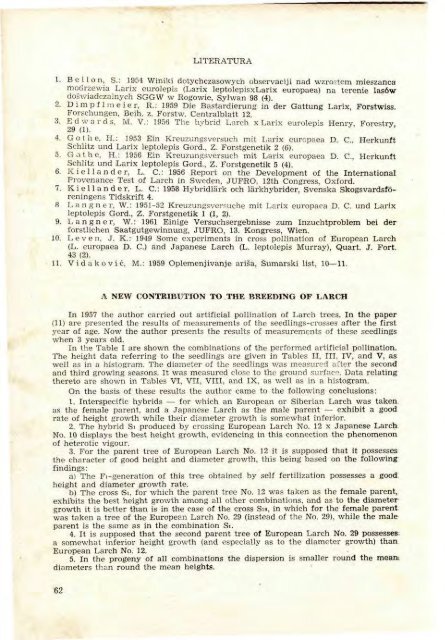Å UMARSKI LIST 1-2/1962
Å UMARSKI LIST 1-2/1962
Å UMARSKI LIST 1-2/1962
You also want an ePaper? Increase the reach of your titles
YUMPU automatically turns print PDFs into web optimized ePapers that Google loves.
LITERATURA<br />
1. Bel Ion, S.: 1954 Winiki dotychczasowych observaciji nad wzrostem mieszanca<br />
modrzewia Larix eurolepis (Larix leptolepisxLarix europaea) na terenie lasöw<br />
doswiadczainych SGGW w Rogowie, Sylwan 98 (4).<br />
2. Dimpf lrneier, R.: 1959 Die Bastardierung in der Gattung Larix, Forstwiss.<br />
Forschungen, Beih. z. Forstw. Centralblatt 12.<br />
3. Edwards, M. V.: 1956 The hybrid Larch x Larix eurolepis Henry, Forestry<br />
29 (1).<br />
4. Go the, H.: 1953 Ein Kreuzungsversuch mit Larix eurcpaea D. C, Herkunft<br />
Schlitz und Larix leptolepis Gord., Z. Forstgenetik 2 (6).<br />
5. Go the, H.: 1956 Ein Kreuzungsversuch mit Larix europaea D. C, Herkunft<br />
Schlitz und Larix leptolepis Gord., Z. Forstgenetik 5 (4).<br />
6. Kiellander, L. C: 1956 Report on the Development of the International<br />
Provenance Test of Larch in Sweden, JUFRO, 12th Congress, Oxford.<br />
7. Kiellander, L. C: 1958 Hybridlärk och lärkhybrider, Svenska Skogsvardsföreningens<br />
Tidskrift 4.<br />
8 Langner, W.: 1951-52 Kreuzungsversuche mit Larix europaea D. C. und Larix<br />
leptolepis Gord., Z. Forstgenetik 1 (1, 2).<br />
9. Langner, W.: 1961 Einige Versuchsergebnisse zum Inzuchtproblem bei der<br />
forstlichen Saatgutgewinnung, JUFRO, 13. Kongress, Wien.<br />
10. L e v e n, J. K.: 1949 Some experiments in cross pollination of European Larch<br />
(L. europaea D. C.) and Japanese Larch (L. leptolepis Murray), Quart. J. Fort.<br />
43 (2).<br />
11. V i d a k o v i ć, M.: 1959 Oplemenjivanje ariša, Šumarski list, 10—11.<br />
A NEW CONTRIBUTION TO THE BREEDING OF LARCH<br />
In 1957 the author carried out artificial pollination of Larch trees. In the paper<br />
(11) are presented the results of measurements of the seedlings-crosses after the first<br />
year of age. Now the author presents the results of measurements of these seedlings<br />
when 3 years old.<br />
In the Table I are shown the combinations of the performed artificial pollination.<br />
The height data referring to the seedlings are given in Tables II, III, IV, and V, as<br />
well as in a histogram. The diameter of the seedlings was measured after the second<br />
and third growing seasons. It was measured close to the ground surface. Data relating<br />
thereto are shown in Tables VI, VTI, VIII, and IX, as well as in a histogram.<br />
On the basis of these results the author came to the following conclusions:<br />
1. Interspecific hybrids — for which an European or Siberian Larch was taken<br />
as the female parent, and a Japanese Larch as the male parent — exhibit a good<br />
rate of height growth while their diameter growth is somewhat inferior.<br />
2. The hybrid Si produced by crossing European Larch No. 12 x Japanese Larch<br />
No. 10 displays the best height growth, evidencing in this connection the phenomenon<br />
of heterotic vigour.<br />
3. For the parent tree of European Larch No. 12 it is supposed that it possesses<br />
the character of good height and diameter growth, this being based on the following<br />
findings:<br />
a) The Fi-generation of this tree obtained by self fertilization possesses a good.<br />
height and diameter growth rate.<br />
b) The cross iSi, for which the parent tree No. 12 was taken as the female parent,<br />
exhibits the best height growth among all other combinations, and as to the diametergrowth<br />
it is better than is in the case of the cross Sio, in which for the female parent<br />
was taken a tree of the European Larch No. 29 (instead of the No. 29), while the male<br />
parent is the same as in the combination Si.<br />
4. It is supposed that the second parent tree of European Larch No. 29 possesses,<br />
a somewhat inferior height growth (and especially as to the diameter growth) than<br />
European Larch No. 12.<br />
5. In the progeny of all combinations the dispersion is smaller round the mean,<br />
diameters then round the mean heights.<br />
62
















